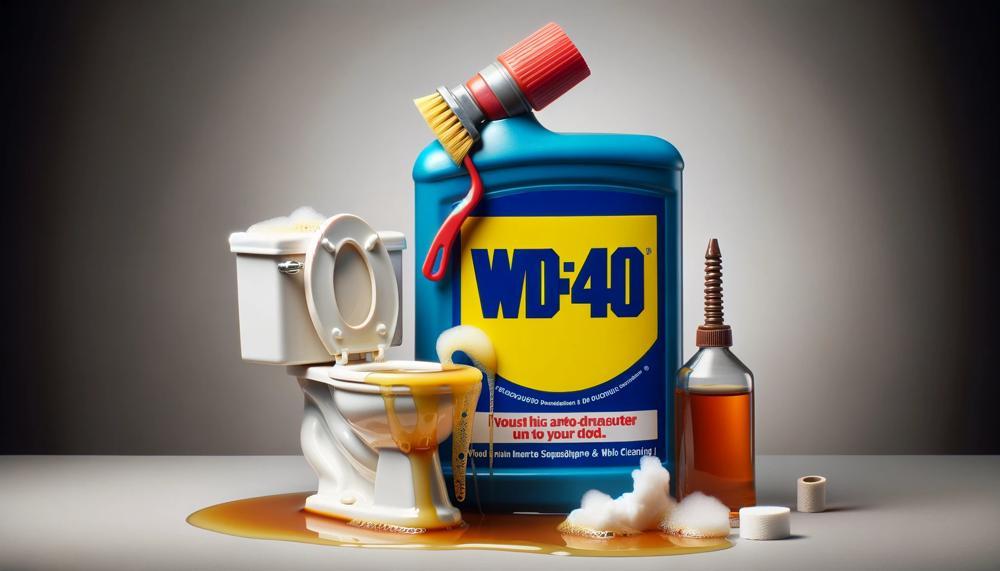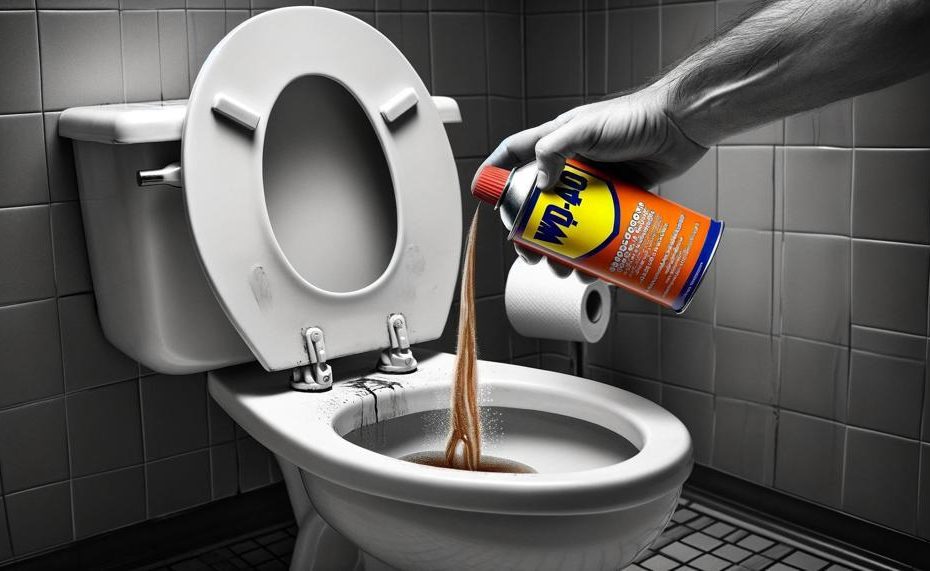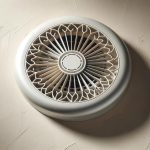Are you sick of cleaning your toilet over and over again but still seeing spots and grime that won’t come off? Do you hate the thought of cleaning your toilet because you know it will take a lot of time and work? The answer to your toilet cleaning problems is something that doesn’t seem likely: WD-40. That’s right, the same product that is great for avoiding rust and keeping things moving smoothly can also clean toilets really well.
So, how do you clean a toilet with wd 40?
Here’s how you can clean a toilet with WD-40:
- Remove the water at the bottom of the toilet bowl using a cup or a sponge.
- Spray WD-40 on the toilet bowl, specifically targeting the stains.
- Allow the WD-40 to sit for 2 to 5 minutes to dissolve the stains.
- Use a toilet brush to scrub the toilet bowl, including the rim and the outlet.
- Flush the toilet to remove all the stains.
Please note that WD-40 is quite potent, so make sure the area is well ventilated when you’re using it2. Also, it’s recommended to use the original WD-40 for the best results.
Get ready to revolutionize your toilet cleaning routine with this unexpected but highly effective solution – WD-40.
Contents
Can You Use WD-40 To Clean Toilets? Is It Safe?
Indeed, the original formulation of WD-40 is a safe and effective choice for cleaning toilets.
Unlike other cleaning products, it is specifically designed to eliminate the need for multiple products and is gentle enough to use on toilet surfaces without causing any harm.
Not only does WD-40 effectively remove stains, but it also leaves your toilet looking and smelling fresh.
| 1 | Thoroughly spray the inside of the toilet bowl with WD-40, ensuring complete coverage of all stained areas. | This allows the powerful formulation to settle in and effectively break down even the toughest of stains. |
| 2 | Allow it to sit for 10-15 minutes. | This waiting period is crucial as it gives the formulation enough time to work its magic on stubborn stains. |
| 3 | Vigorously scrub the toilet bowl with a clean brush. | Using a clean brush is vital in preventing the spread of bacteria or other contaminants within your toilet. |
| 4 | Thoroughly rinse with water. | This step is essential in preventing overexposure to the formulation and ensuring a clean finish. |
Additional Tips:
- For tougher stains, an additional application may be necessary.
- To avoid strong fumes, it is recommended to provide proper ventilation in the bathroom while using WD-40.
- Make sure to rinse the toilet bowl thoroughly after cleaning to avoid any residue.
- Using WD-40 can also help prevent future stains from appearing on your toilet.
- Avoid using WD-40 on waxed or painted surfaces as it may cause damage.
- Keep in mind that WD-40 is only suitable for cleaning the inside of the toilet bowl and should not be used on the tank or other external parts.
How To Clean A Toilet Using WD-40
Cleaning a toilet with WD-40 is a fantastic alternative to traditional cleansers, as it effectively eliminates stains and buildup without harsh chemicals.
This method is also cost-effective and simple to execute, making it a popular choice among DIY enthusiasts.
Prepare the Toilet Bowl
Before applying WD-40, it’s important to remove the water at the bottom of the toilet bowl. This ensures that the product can effectively target stains and buildup. You can use a cup or sponge to drain the water.
Spray WD-40 on the Toilet Bowl
Next, spray WD-40 directly onto the toilet bowl, focusing on areas with stains or buildup. The original formulation of WD-40 is recommended for optimal results in removing hard water stains. Make sure to cover the entire bowl, including the rim and outlet.
Allow it to Sit
Let the WD-40 sit for 10-15 minutes to dissolve stains and buildup.
This will make it easier to scrub and remove them later on.
Scrub with a Toilet Brush
After letting WD-40 sit for a few minutes, use a clean toilet brush to scrub the bowl.
Be sure to scrub all areas, including under the rim and around the outlet.
Flush the Toilet
Once you have thoroughly scrubbed the toilet bowl, flush it to rinse away any remaining residue and confirm that all stains are gone.
Repeat if Needed
For tougher stains, you may need to repeat the process.
Simply spray a small amount of WD-40 into the bowl, let it sit for a few minutes, then scrub with your toilet brush.
Ventilate the Bathroom
Due to its potent fumes, it’s crucial to ventilate the bathroom while using WD-40. Open windows or turn on a fan to ensure proper ventilation.
Does WD-40 Remove Hard Water Stains In Toilets?
The answer is affirmative. The versatile household product is well-known for its ability to lubricate, protect, and clean various surfaces.
With its powerful formula, it can break down mineral and lime deposits, making them easier to scrub away.
However, there are some important things to keep in mind when using WD-40 in toilets.
Pros:
- Removes hard water stains: The main component of WD-40 is petroleum distillates, which effectively dissolves mineral and lime deposits that cause hard water stains. This makes it a highly efficient solution for removing unsightly stains in the toilet bowl.
- Breaks down grime and build-up: Aside from hard water stains, WD-40 can also disintegrate tough grime and build-up, including rust stains. This makes it a versatile option for deep cleaning the toilet.
- Affordable option: Compared to other commercial cleaners, WD-40 is a cost-effective choice for cleaning toilets. A little goes a long way, making it an affordable option for regular use.
Cons:
- Unsafe chemical composition: While WD-40 may be effective in removing hard water stains, its chemical composition can be hazardous if not used properly. It contains ingredients like petroleum distillates, long-chain hydrocarbons, and xylene that can be harmful if ingested or inhaled.
- Potential risks: Due to its chemical composition, there are some potential risks associated with using WD-40 in toilets. It is important to take proper precautions and avoid contact with skin or eyes.
- Alternative options available: For those who prefer a safer and more environmentally friendly option, vinegar is a great alternative for removing hard water stains and rust in the toilet. A combination of vinegar and baking soda can also effectively tackle tough stains.
Does WD-40 Remove Rust Stains From Toilets?
Absolutely. The lubricating properties and solvent strength of WD-40 make it a formidable cleaner for eliminating rust stains.
However, caution must be exercised when using WD-40 in toilets as its chemical composition can be harmful if inhaled or ingested.
It is recommended to first try safer alternatives like vinegar or baking soda before resorting to WD-40.
| Ingredients in WD-40 | Potential Health Risks | Safe Alternatives |
| Mineral spirits | May cause respiratory irritation if inhaled | Vinegar, lemon juice |
| Liquefied petroleum gas (LPG) | Highly flammable and may cause respiratory irritation if inhaled | Baking soda, borax powder |
| Mineral oil | Can lead to skin irritation and may be harmful if ingested | Coke, pumice stone (with caution) |
Tips To Prevent Hard Water Stains In Your Toilet
To avoid hard water stains in your toilet using WD-40, you can follow these helpful tips:
Consistent Cleansing
The most effective way to prevent hard water stains is to regularly clean your toilet.
Not only will this maintain a clean and refreshing appearance, but it will also prevent mineral buildup that can result in hard water stains.
Ensure to use a safe cleaner for your toilet, as harsh chemicals can cause damage.
Reserve WD-40 as a Last Resort
If regular cleaning does not suffice, WD-40 can be utilized as a last resort.
However, it is important to note that WD-40 is not a disinfectant and does not kill bacteria. Therefore, it should not be used in place of regular cleaning products.

Utilize the Original Formula
When using WD-40 to eliminate hard water stains, it is recommended to use the original formulation.
This is because the original formula contains more solvents, making it more effective in breaking down rust and mineral buildup.
Properly Apply
For optimal results, use a wide spray bottle to ensure better coverage when applying WD-40 to remove hard water stains. Spray a small amount into the toilet bowl and let it sit for 10-15 minutes before scrubbing with a clean brush.
After scrubbing, flush the toilet to reveal a clean bowl.
Repeat if Needed
In cases of stubborn stains, the process may need to be repeated multiple times for best results.
It is important to ventilate the bathroom while using WD-40 due to its strong fumes.
By following these guidelines, you can effectively prevent hard water stains in your toilet by utilizing WD-40.
How Else Can I Use WD-40 In The Bathroom?
There are numerous effective ways to utilize WD-40 in the bathroom. Here are some suggestions:
- Eliminate rust from metal fixtures: Apply WD-40 to a cloth and wipe away rust from metal fixtures like showerheads, faucets, and towel racks. This not only eliminates rust but also provides protection against future corrosion.
- Prevent buildup of soap scum: After cleaning, spray WD-40 on your shower walls and tub to prevent soap scum buildup. This will make it easier to clean the next time.
- Clean and polish chrome surfaces: Use a cloth with a small amount of WD-40 to clean and polish chrome surfaces such as faucets, towel bars, and shower caddies.
- Eradicate hair dye stains: If you accidentally get hair dye on your bathroom counter or sink, spray WD-40 on the stain and let it sit for a few minutes before wiping it away with a cloth.
- Lubricate squeaky hinges: Apply WD-40 to squeaky cabinet or shower door hinges to eliminate the annoying noise.
- Remove hard water stains from shower doors: Spray WD-40 on hard water stains on your shower doors and let it sit for a few minutes before wiping it away with a cloth.
- Prevent growth of mildew on grout: Spray WD-40 on grout lines in your shower or bathtub to prevent the growth of mildew.
- Eliminate adhesive residue: If you struggle with removing sticky labels or tape residue, spray WD-40 on the area and let it sit for a few minutes before wiping it away with a cloth.
- Clean tile floors: Use WD-40 to remove scuff marks and dirt from tile floors by spraying it directly onto the affected area and wiping it away with a cloth.
- Protect against water damage: Use WD-40 on wooden bathroom cabinets or furniture to safeguard them from water damage. Simply spray a small amount on a cloth and rub it on the surface to create a water-resistant barrier.
Conclusion
Overall, keeping the toilet clean isn’t a hard or boring job.
Thanks to WD-40, it’s easy to get rid of tough spots and grime, leaving your toilet shiny with little work. It is a flexible and useful choice for cleaning because it has strong solvents and rubbing qualities.
But be careful whenever you use WD-40, and if you need to, think about better options.





